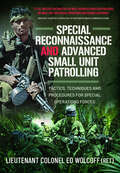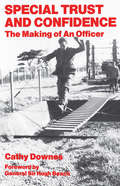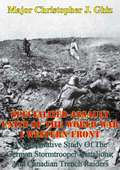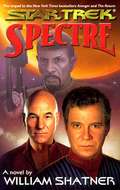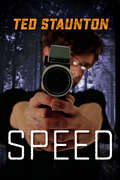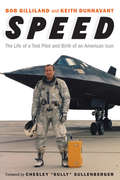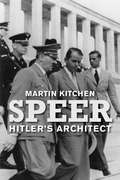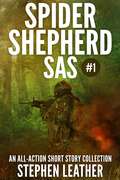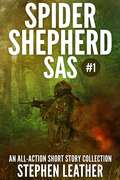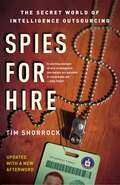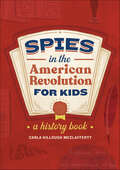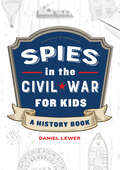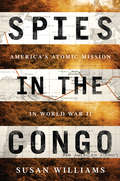- Table View
- List View
Special Reconnaissance and Advanced Small Unit Patrolling: Tactics, Techniques and Procedures for Special Operations Forces
by Edward WolcoffComprehensive guide on Special Forces Tactics, Techniques, and Procedures written by a special operations combat veteran.This book will serve as a tactical “bible” tailored to the military Special Operations, intelligence and paramilitary/law-enforcement communities and other interested parties – with the intention of breaking the invent-and-forget/reinventing-the-wheel cycle with an aim to (1) increase the effectiveness and lethality of SpecOps personnel and units, while (2) saving the lives of SpecOps personnel engaged in high-risk operations. Wolcoff describes numerous historical examples of special reconnaissance (SR) operations, with some emphasis on lessons-learned/Tactics, Techniques, and Procedures gained from the legendary Military Assistance Command Vietnam – Studies and Observations Group (MACV-SOG) SR operations conducted during the Vietnam-era, including operational accounts and analyses of specific missions. Few of these TTPs and lessons-learned have been archived or collated into a usable form for SpecOps personnel or units; this book is intended to preserve and embed this valuable and volatile compilation of tradecraft, that has been obtained at such cost in lives. Wolcoff covers the gamut of specialized SR topics ranging from operational planning and preparation, through execution, logistics and command and control – all in substantial trade-craft detail.
Special Trust and Confidence: The Making of an Officer
by Cathy DownesThis is an examination and an analysis of the systems of recruitment, selection, education and training for junior officers in the British Armed Forces. It is a study based around four core institutions: The Royal Military Academy, Sandhurst, The Britannia Royal Naval College, Dartmouth, the Department of Initial Officer Training, Royal Air Force College, Cranwell and the Officers Training Wing, Commando Training Centre, Royal Marines, Lympstone. The conclusions reveal the enduring dilemmas involved in the preparation of officer aspirants for entry to the British military profession.
Specialized Assault Units Of The World War I Western Front: A Comparative Study Of The German Stormtrooper Battalions, And Canadian Trench Raiders
by Major Christopher J. GhizThis thesis will use a comparative study of the German Storm trooper battalions and the Canadian trench raiders in order to examine the dynamics of the World War I battlefield, the role of military culture in adaptation in order to acknowledge and act on the requirements of battlefield innovation. The purpose is to determine what key factors contributed to the tactical effectiveness of specialized assault units on the Western Front. The military cultures of these armies comprised the logical and innovative principles that were fundamental in the tactical effectiveness of these elite assault units by making revolutionary developments in force structure, institutional support, personnel selection, decentralized leadership, and training on small-unit tactics and advanced weaponry. Did these tactics create similar or different effects for each army? What factors did these armies use to organize and employ these assault units? To answer these questions, several areas will be examined: (1) force structure, (2) institutional support, (3) personnel selection, and (4) training on decentralized leadership, small unit infiltration tactics, and advanced weaponry. Both armies had different backgrounds and situations. The German Army's Sturm battalions represented an army-wide institutionalization of organization, selection and technique. The Canadian Corps' trench raiders were based on the Canadian Corps' homogeneous structure that separated itself from the BEF in developing its own doctrine, training schools, organization, and tactical innovations.
Specter (Seal Team Seven, #2)
by Keith DouglassThird Platoon, SEAL Team Seven, is just recovering from a secret intelligence-gathering mission in Croatia and Bosnia that was supposed to have been a quick sneak-and-peek, but turned out to be a massive firefight from which they barely escaped with their lives, when a Greek jet, carrying a U.S. congresswoman is hijacked. After some intelligence-gathering, it is discovered that the congresswoman and her staff are being held in a medieval castle in Macedonia and Third Platoon is preparing for another mission, a hostage rescue, into the war-torn Balkans.
Spectre: Shatnerverse: Mirror Universe (Star Trek)
by William Shatner Judith Reeves-StevensRetired and happily in love, Kirk believes his adventuring days are over. But as he returns to Earth for the first time since his apparent "death" upon the Enterprise-B, events elsewhere in the galaxy set in motion a mystery that may provide Kirk with his greatest challenge yet. The Enterprise-E, under the command of Captain Jean-Luc Picard, is exploring an unstable region of space on a scientific mission of vital concern to Starfleet when they discover the last thing they ever expected to find: a lonely, battle-scarred vessel that is instantly recognizable to every member of Picard's crew. Five years after being lost with all hands in the Delta Quadrant, the Starship Voyager has come home! The commander of Voyager, one Tom Paris, explains that Captain Kathryn Janeway and half of the original crew is dead, but if that is true, who is the mysterious woman who has kidnapped Kirk back on Earth, pleading with him to assist her against a threat to the entire Federation? All is not as it seems, and soon Kirk is forced to confront the hideous consequences of actions taken more than a hundred years prior, as well as his own inner doubts. After years of quiet and isolation, does he still have what it takes to put things right-and join with Captain Picard to save the lives of everyone aboard a brand-new Enterprise? An unforgettable saga peopled by old friends and ancient enemies, Star Trek: Spectre propels Kirk on a journey of self-discovery every bit as harrowing as the cataclysmic new adventure that awaits him.
Speed (The Seven Prequels #5)
by Ted StauntonHow can you liven up a boring camping trip with your grandpa and your younger brother? Spencer has the answer: lose the new cell phone you weren't supposed to bring with you. Add a War of 1812 reenactment, a student film crew, an old flame of Grandpa's, Laura Secord's cowbell and a larcenous hardcore history buff, and you get a weekend that gives Spencer his first taste of independence and maybe a glimpse of his future, by way of the past. In this funny prequel to Jump Cut and Coda, the goofy and creative Spencer gets caught up in a War of 1812 reenactment.
Speed and Power
by John Halliday Eric Peltz Aimee BowerUsing a case study based on the Army's new Stryker Brigade Combat Team, the authors explore how the Army might improve its ability to contribute to prompt, global power projection, that is, strategically responsive early-entry forces for time-critical events. The authors examine options to reach a dual goal: to initiate deployment of the right force capabilities, and then get those capabilities where they need to be as quickly as possible.
Speed: The Life of a Test Pilot and Birth of an American Icon
by Keith Dunnavant Bob GillilandOn December 22, 1964, at a small, closely guarded airstrip in the desert town of Palmdale, California, Lockheed test pilot Bob Gilliland stepped into a strange-looking aircraft and roared into aviation history. Developed at the super-secret Skunk Works, the SR-71 Blackbird was a technological marvel. In fact, more than a half century later, the Mach 3–plus titanium wonder, designed by Clarence L. &“Kelly&” Johnson, remains the world&’s fastest jet. It took a test pilot with the right combination of intelligence, skill, and nerve to make the first flight of the SR-71, and the thirty-eight-year-old Gilliland had spent much of his life pushing the edge. In Speed one of America&’s greatest test pilots collaborates with acclaimed journalist Keith Dunnavant to tell his remarkable story: How he was pushed to excel by his demanding father. How a lucky envelope at the U.S. Naval Academy altered the trajectory of his life. How he talked his way into U.S. Air Force fighters at the dawn of the jet age, despite being told he was too tall. How he made the conscious decision to trade the security of the business world for the dangerous life of an experimental test pilot, including time at the clandestine base Area 51, working on the Central Intelligence Agency&’s Oxcart program. The narrative focuses most intently on Gilliland&’s years as the chief test pilot of the SR-71, as he played a leading role in the development of the entire fleet of spy planes while surviving several emergencies that very nearly ended in disaster. Waging the Cold War at 85,000 feet, the SR-71 became an unrivaled intelligence-gathering asset for the U.S. Air Force, invulnerable to enemy defenses for a quarter century. Gilliland&’s work with the SR-71 defined him, especially after the Cold War, when many of the secrets began to be revealed and the plane emerged from the shadows—not just as a tangible museum artifact but as an icon that burrowed deep into the national consciousness. Like the Blackbird itself, Speed is a story animated by the power of ambition and risk-taking during the heady days of the American Century.
Speer: Hitler's Architect
by Martin Kitchen&“Sets the record straight on Albert Speer&’s assertions of ignorance of the Final Solution and claims to being the &‘good Nazi.&’&”—Kirkus Reviews In his bestselling autobiography, Albert Speer, Minister of Armaments and chief architect of Nazi Germany, repeatedly insisted he knew nothing of the genocidal crimes of Hitler&’s Third Reich. In this revealing new biography, author Martin Kitchen disputes Speer&’s lifelong assertions of ignorance and innocence, portraying a far darker figure who was deeply implicated in the appalling crimes committed by the regime he served so well. Kitchen reconstructs Speer&’s life with what we now know, including information from valuable new sources that have come to light only in recent years. The result is the first truly serious accounting of the man, his beliefs, and his actions during one of the darkest epochs in modern history, not only countering Speer&’s claims of non-culpability but also disputing the commonly held misconception that it was his unique genius alone that kept the German military armed and fighting long after its defeat was inevitable. &“A devastating portrait of an empty, narcissistic and compulsively ambitious personality.&”—The Wall Street Journal &“Kitchen&’s exhaustively researched, detailed book nails, one by one, the lies of the man who provided a thick coat of whitewash to millions of old Nazis. Its fascinating account of how the moral degradation of the chaotic Nazi regime corrupted an entire nation is a timely warning for today.&”—Daily Mail (&“Book of the Month&”) &“[An] excellent new biography . . . Kitchen has taken a wrecking ball to Speer&’s mendacious and meticulously created self-image. And about time, too.&”—History Today
Spellsinger (Gateway Essentials #344)
by Alan Dean FosterIt was where beasts walked and talked as men, armed with swords and daggers. And it was where Clothahump, turtle and wizard, stretched his powers of sorcery to their limit, reaching out to another universe, seeking help to combat the force of evil emanating from the dreaded Greendowns. And so Jonathan Meriweather found himself plucked from his peaceful university life and catapulted into a strange new world to become part of a very strange fellowship. Soldier and crusader, fighting with sword and song, he is the Spellsinger.
Spetsnaz: Russia's Special Forces
by Johnny Shumate Mark GaleottiWhen the shadowy, notorious Spetsnaz were first formed, they drew on a long Soviet tradition of elite, behind-the-lines commando forces from World War II and even earlier. Throughout the 1960s-70s they were instrumental both in projecting Soviet power in the Third World and in suppressing resistance within the Warsaw pact. As a powerful, but mysterious tool of a world superpower, the Spetsnaz have inevitably become the focus of many 'tall tales' in the West. In this book, a peerless authority on Russia's military Special Forces debunks several of these myths, uncovering truths that are often even more remarkable. Now, since the chaotic dissolution of the USSR and the two Chechen Wars, Russian forces have seen increasing modernization, involving them ever more in power-projection, counter-insurgency and anti-terrorism and the Spetsnaz have been deployed as a spearhead in virtually all of these operations. This book offers a unique, absorbing guide to the secrets of the Spetsnaz, their most noteworthy missions and personalities, but is also packed with details such as orders-of-battle, equipment and operational doctrine.
Spezialkräfte: Heldenhafte Geschichten aus aller Welt
by Steve StoneSpezialeinheiten sind Militäreinheiten, die für unkonventionelle Einsätze ausgebildet sind. Spezialeinheiten entstanden Anfang des 20. Jahrhunderts und erlebten während des Zweiten Weltkriegs mit der Gründung von Spezialeinheiten wie der SAS und den U.S. Navy SEALs einen bedeutenden Aufschwung. Diese Auswahl fesselnder Geschichten von Spezialkräften aus aller Welt. Sie umfasst vier Jahrzehnte erstaunlicher Operationen. Darunter die Operation Adlerkralle, die Operation Gothic Serpent, die Operation Neptune Spear und viele andere actiongeladene Geschichten. Special Forces sind hoch angesehen, und die Soldaten dieser Eliteeinheiten haben ein hartes Auswahl- und Trainingsprogramm durchlaufen, um es an die Front zu schaffen. Ob es sich nun um einen Delta Force-Operator, einen Navy SEAL, einen SAS-Trooper oder einen anderen Special Forces-Operator handelt. Heute ist enge Zusammenarbeit der Schlüssel zu vielen Missionen - auch wenn die Rivalität, der Beste zu sein, der Erste, der ein Ziel erreicht oder derjenige, der ein hochkarätiges Ziel ausschaltet. Die Geschichten in diesem Buch sind so ausgewählt, dass sie nicht nur den Erfolg, sondern auch das Scheitern und die Lehren aus jeder einzelnen Operation zeigen. Hochtechnologie ist nach wie vor kein Ersatz für den Einsatz vor Ort, wo hochqualifizierte Agenten immer noch Informationen sammeln können, zu denen kein Auge aus dem Himmel in der Lage ist.
Spider Shepherd: SAS (Volume I)
by Stephen LeatherDan "Aranha" Spider é o herói da série de bestsellers do Sunday Times, escrita por Stephen Leather. Antes de ser um polícia à paisana e agente do MI5, Aranha foi um soldado e membro da elite dos SAS. Esta coleção de curtas histórias, publicada anteriormente em brochuras, cobrem o período antes de Shepherd se juntar aos SAS, como se saiu nos SAS e como adquiriu a sua alcunha, e detalha as suas aventuras numa Serra Leoa devastada pela guerra. As histórias apresentam muitos dos personagens que aparecem nos livros de Aranha Shepherd. As curtas histórias são - Alvos difíceis, Seleção natural, Fuga à justa, Aviso, Território hostil e Diamantes brutos.
Spider Shepherd: Seis historias cortas con Dan "Spider" Shepherd, el héroe de la serie best-seller del Sunday Times.
by Stephen LeatherDan "Spider" Shepherd es el héroe de la serie más vendida del Sunday Times escrita por Stephen Leather. Antes de ser un policía encubierto y un oficial del MI5, Spider era un soldado y miembro de la élite SAS. Esta colección de cuentos, publicada en rústica por primera vez, cubre el período antes de que Shepherd se uniera al SAS, cómo se inscribió en el SAS y adquirió su apodo y detalla sus aventuras en Sierra Leona, devastada por la guerra. Las historias presentan a muchos de los personajes que aparecen en los libros de Spider Shepherd. Las historias cortas son: objetivos duros, selección natural, escape estrecho, orden de advertencia, territorio hostil y diamantes en bruto.
Spider Shepherd: Una colección de historias cortas de acción (Spider Shepherd: SAS #2)
by Stephen LeatherEl segundo volumen de seis historias cortas de Spider Shepherd en un solo volumen por el autor de bestsellers Stephen Leather. Las historias cortas son: Protección Personal, La Cuerda, Paquete de Planeación, Fuego Amigo, Descarga de Muertos y Zona Mortal, las cuales presentan a Dan "Spider" Shepherd, cuyas aventuras han sido bestsellers del Sunday Times.
Spiders from the Shadows (Wrath & Righteousness #Episode Nine)
by Chris StewartINTO THE LION'S DEN <p><p> "The battle wasn't starting. It was almost over. There was nothing he could do now, no way to stop the coming wave from crashing down. He had walked into a den of predators so full of jealousy and fury that they couldn't reason anymore. They were outsiders on the inside, the cancer next to the bone, the disease that would kill the nation after having lain dormant all these years." <p> As the forces of Darkness work to consolidate worldwide power into a new regime, the Secretary of Defense realizes that he is the Republic's last chance. With the former FBI Director by his side, the two men launch a daring plan to infiltrate Raven Rock--a secure underground military complex that is hosting the new government. <p> But Lucifer and his accomplices are not sitting idly by. After taking the FBI Director in to Raven Rock they launch a brilliant propaganda counterstrike that the SecDef never saw coming. <p> With no obstacles left in their way, the group of six men prepare to leave Raven Rock to begin reassembling the world they've destroyed. But the SecDef isn't ready to give in. With one last card to play, he sends one of his most trusted allies, a woman with no experience in combat or espionage, on a life or death mission directly into the lion's den. <p> Against the backdrop of torn-from-the-headlines Middle Eastern drama, the Wrath & Righteousness series is a fast-paced thriller that explores man's role in the eternal battle between good and evil. <p> Wrath & Righteousnessis a ten episode e-book series by Chris Stewart, a world-record-setting Air Force pilot (fastest nonstop flight around the world) and New York Times bestselling author of several books, including The Miracle of Freedom.
Spies
by Michael FraynThe National Bestseller The sudden trace of a disturbing, forgotten aroma compels Stephen Wheatley to return to the site of a dimly remembered but troubling childhood summer in wartime London. As he pieces together his scattered memories, we are brought back to a quiet, suburban street where two boys--Keith and his sidekick, Stephen--are engaged in their own version of the war effort: spying on the neighbors, recording their movements, and ferreting out their secrets. But when Keith utters six shocking words, the boy’s game of espionage takes a sinister and unintended turn, transforming a wife’s simple errands and the ordinary rituals of family life into the elements of adult catastrophe. Childhood and innocence, secrecy, lies and repressed violence are all gently laid bare as once again Michael Frayn powerfully demonstrates that what appears to be happening in front of our eyes often turns out to be something we cannot see at all.
Spies
by Richard Ben SapirAn FBI investigation of a German spy ring on American soil threatens to devastate lives, loves, and families forty years after the end of World War II A watertight packet is discovered by a diver in the waters surrounding Block Island. Unrecovered detritus from the last German U-boat sunk off the coast of Rhode Island, it contains secret codes suggesting that a Nazi spy ring operated in the United States during the darkest days of World War II. If confirmed, it could prove a major embarrassment to the FBI--whose late director, J. Edgar Hoover, once assured the government there were no spies in the country--so the Bureau sends one of its best, Unit Chief Todd Oliver, to Newport to investigate. A war that ended four decades earlier is not yet over for some in this New England naval town, as Oliver's mission threatens to destroy the lives and relationships of the guilty and the innocent alike. Suddenly, dark, lingering shadows are everywhere, enveloping respected pillars of the community, the wealthy and powerful in their mansions on "the Avenue," and respectable, law-abiding citizens who merely wish to forget. Even Oliver himself is not safe, as the agent's inquiries into secret wartime espionage begin unraveling strong, sacred bonds of love, friendship, and family, tempting the dedicated operative to compromise everything he stands for in the face of a shocking murder that rocks Newport society to its core.
Spies Who Changed History: The Greatest Spies & Agents of the 20th Century
by Nigel WestSpies have made an extraordinary impact on the history of the 20th Century, but fourteen in particular can be said to have been demonstrably important. As one might expect, few are household names, and it is only with the benefit of recently declassified files that we can now fully appreciate the nature of their contribution. The criteria for selection have been the degree to which each can now be seen to have had a very definite influence on a specific course of events, either directly, by passing vital classified material, or indirectly, by organizing or managing a group of spies. Those selected were active in the First World War, the inter-war period, the Second World War, the Cold War and even the post-Cold War era. These include Walther Dewé who formed a spy ring in German-occupied Belgium during the First World War. This train-watching network, known as ‘White Lady’, reported on German troop deployments and possible weaknesses in the German defences. Extending its operations into northern France, the ring provided 75 per cent of the information received by GHQ, British Expeditionary Force. By the time of the Armistice in 1918, Dewé’s group had a staggering 1,300 members. Olga Gray, the 27-year-old daughter of a Daily Mail journalist, was employed as a secretary by the Communist Party of Great Britain. In 1931 she undertook a mission for MI5 to penetrate the organization and discover its secret channel of communication with Moscow. Gray learned that the Party’s cipher was based on Treasure Island and this breakthrough enabled the Party’s messages to be read by Whitehall cryptographers. Renato Levi, an Italian playboy, was the longest-serving British agent of the Second World War and is credited with creating the concept of strategic deception. While operating in Cairo as a double agent working for the Abwehr and the British he was instrumental in misleading the Axis about Allied strength across the Middle East and helped Montgomery achieve his victory over Rommel’s Afrika Korps at El Alamein. So successful was Levi in this and other deceptions, he was employed to persuade the Germans that the D-Day landings in Normandy were a diversionary feint, in anticipation of an invasion in the Pas-de-Calais. These, and other surprising stories, are revealed in this fascinating insight into a secret world inhabited by mysterious and shadowy characters, all of whom, though larger than life, really did exist.
Spies for Hire: The Secret World of Intelligence Outsourcing
by Tim ShorrockIn Spies for Hire, investigative reporter Tim Shorrock lifts the veil off a major story the government doesn't want us to know about -- the massive outsourcing of top secret intelligence activities to private-sector contractors. Running spy networks overseas. Tracking down terrorists in the Middle East. Interrogating enemy prisoners. Analyzing data from spy satellites and intercepted phone calls. All of these are vital intelligence tasks that traditionally have been performed by government officials accountable to Congress and the American people. But that is no longer the case. Starting during the Clinton administration, when intelligence budgets were cut drastically and privatization of government services became national policy, and expanding dramatically in the wake of 9/11, when the CIA and other agencies were frantically looking to hire analysts and linguists, the Intelligence Community has been relying more and more on corporations to perform sensitive tasks heretofore considered to be exclusively the work of federal employees. This outsourcing of intelligence activities is now a $50 billion-a-year business that consumes up to 70 percent of the U. S. intelligence budget. And it's a business that the government has tried hard to keep under wraps. Drawing on interviews with key players in the Intelligence-Industrial Complex, contractors' annual reports and public filings with the government, and on-the-spot reporting from intelligence industry conferences and investor briefings,Spies for Hire provides the first behind-the-scenes look at this new way of spying. Shorrock shows how corporations such as Booz Allen Hamilton, Lockheed Martin, SAIC, CACI International, and IBM have become full partners with the CIA, the National Security Agency, and the Pentagon in their most sensitive foreign and domestic operations. He explores how this partnership has led to wasteful spending and threatens to erode the privacy protections and congressional oversight so important to American democracy. Shorrock exposes the kinds of spy work the private sector is doing, such as interrogating prisoners in Iraq, managing covert operations, and collaborating with the National Security Agency to eavesdrop on Americans' overseas phone calls and e-mails. And he casts light on a "shadow Intelligence Community" made up of former top intelligence officials who are now employed by companies that do this spy work, such as former CIA directors George Tenet and James Woolsey. Shorrock also traces the rise of Michael McConnell from his days as head of the NSA to being a top executive at Booz Allen Hamilton to returning to government as the nation's chief spymaster. From CIA covert actions to NSA eavesdropping, from Abu Ghraib to Guantánamo, from the Pentagon's techno-driven war in Iraq to the coming global battles over information dominance and control of cyberspace, contractors are doing it all. Spies for Hire goes behind today's headlines to highlight how private corporations are aiding the growth of a new and frightening national surveillance state.
Spies in the American Revolution for Kids: A History Book (Spies in History for Kids)
by Carla Killough McClaffertySneak kids ages 8 to 12 behind enemy lines with this book about America's first spies If you want to get kids interested in history, the intrigue-filled tales of spies are a great place to start. Packed with exciting stories about the brave men and women who fought off the battlefield, this unique look into the American Revolution helps history come alive through explorations of secretive plots, inventive tools, and daring disguises that are sure to captivate kids.Go beyond other Revolutionary War books for kids with:Spies and the American Revolution—This book teaches kids about the American Revolutionary War and the many spies that played key roles in the conflict.Techniques, tools, and more—Kids will find out about the clever ways spies did their jobs with invisible ink, hidden messages, yarn balls, and hanging laundry.Illustrated history—Keep kids engaged with awesome full-color drawings of historical moments, spy gadgets, battle maps, and more.Show kids how exciting US history can be with Spies in the American Revolution for Kids.
Spies in the Civil War for Kids: A History Book (Spies in History for Kids)
by Daniel LewerThis history book for kids provides a unique look into the Civil War through explorations of cunning plots, inventive gadgets, and clever disguises that are fascinating!Send spy-enthusiasts, ages 8 to 12, behind enemy lines with top-secret Civil War history. Filled with exciting stories about the brave men and women who fought in the war, the secretive tales of spies are a great place to start. When it comes to getting kids interested in history, this book goes above and beyond with:A complete overview—This book teaches kids about the Civil War and the many spies that played key roles in the conflict.Spy tools—Kids will discover the unbelievable ways spies outsmarted their enemies with boiled eggs, fake cannons, and signal flags.Illustrated history—Awesome full-color drawings of historical moments, spy gadgets, battle maps, and more keep kids engaged.Show kids how fun learning about US history can be with Spies in the Civil War for Kids!
Spies in the Congo: America's Atomic Mission in World War II
by Susan WilliamsIn the 1940s, the brightest minds of the United States and Nazi Germany raced to West Africa with a single mission: to secure the essential ingredient of the atomic bomb-and to make sure nobody saw them doing itAlbert Einstein told President Franklin D. Roosevelt in 1939 that the world's only supply of uniquely high-quality uranium ore-the key ingredient for bomb- could be found in the Katanga province of the Belgian Congo at the Shinkolobwe Mine. Once the US Manhattan Project was committed to developing atomic weapons for the war against Germany and Japan, the rush to procure this uranium became a top priority-one deemed "vital to the welfare of the United States.”But covertly exporting it from Africa posed a major risk: the ore had to travel via a spy-infested Angolan port or 1,500 miles by rail through the Congo, and then be shipped by boats or Pan Am Clippers to safety in the United States. It could be poached or smuggled at any point on the orders of Nazi Germany. To combat that threat, the US Office of Strategic Services sent in a team of intrepid spies, led by Wilbur Owings "Dock” Hogue, to be America's eyes and ears and to protect its most precious and destructive cargo. Packed with newly discovered details from American and British archives, this is the gripping, true story of the unsung heroism of a handful of good men-and one woman-in colonial Africa who risked their lives in the fight against fascism and helped deny Hitler his atomic bomb.
Spies of No Country: Behind Enemy Lines at the Birth of the Israeli Secret Service
by Matti FriedmanFrom the award-winning and critically-acclaimed author of Pumpkinflowers, the never-before-told story of the mysterious "Arab Section": the Jewish-"Arab" spies who, under deep cover in Beirut as refugees, helped the new State of Israel win the War of Independence.In his third non-fiction book, Matti Friedman introduces us to four unknown young men who are caught up in the fraught events surrounding the birth of Israel in 1948 and drawn into secret lives, becoming the nucleus of Israel's intelligence service. The tiny, amateur unit known as the "Arab Section" was conceived during WWII by British spies and by Jewish militia leaders in Palestine. Consisting of Jews from Arab countries who could pass as Arabs, it was meant to gather intelligence and carry out sabotage and assassinations. When the first Jewish-Arab war erupted in 1948 and Palestinian refugees began fleeing the fighting, a small number of Section agents disguised as refugees joined the exodus. They fled to Beirut, where they spent the next two years under cover, sending messages back to Israel over a radio antenna disguised as a clothesline. Of the dozen men in the unit at the war's beginning, five were caught and executed. Espionage, John le Carré once wrote, is the "secret theater of our society." Spies of No Country is not just a spy story, but a surprising window into the nature of Israel--a country that sees itself as belonging to the story of Europe, but where more than half of the population is native to the Middle East. Starring complicated characters with slippery identities moving in the shadow of great events, Spies of No Country tells a very different story about what Israel is and how it was created.
